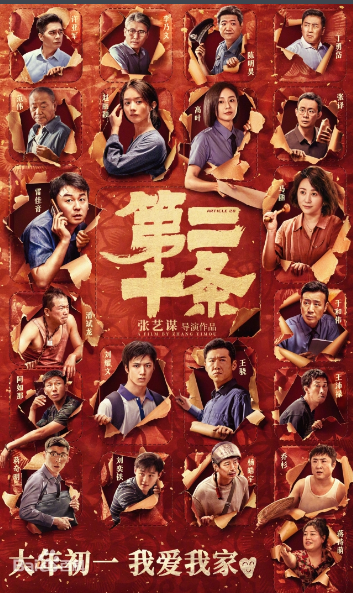《Article 20》What kind of story is told?
The currently airing - Article 20 - can be said to have become one of the most popular film and television dramas at present. Its excitement is not only visible on the screen, but also spreads to the center of the audience, forming a wide resonance.Next, the editor will talk about what kind of story was told in 《Article 20》.

The movie - Article 20 - leads the audience into a world full of complexity and authenticity through the unique perspective of the protagonist Han Ming.Han Ming, a middle-aged prosecutor, is standing at a crossroads in his career. He faces not only cold legal provisions and complicated cases, but also the deep-seated human, moral and emotional entanglements hidden behind them.
The incident of the bus driver's self-defense and counterattack in the film is like a bright mirror, reflecting society's vague understanding of legitimate defense.In an emergency, people often instinctively defend themselves, but how should such behavior be accurately defined legally?When handling this case, Han Ming not only studied the legal provisions in depth, but also carefully explored the driver's mental state and behavioral motives at the time.This is a process full of challenges, and it is also a profound test of Han Ming's legal beliefs and professional ethics.
At the same time, the violent resistance cases on campus in the film have touched the sensitive nerves of society.Students are often in a vulnerable position when facing campus violence. Is their resistance out of a sense of justice to protect themselves and others, or does it go beyond the scope of the law?When Han Ming handles this case, he not only has to consider the provisions of the law, but also weighs social expectations and moral judgment.This is a process that requires careful consideration and difficult decisions, and is also a profound manifestation of Han Ming's social responsibility and moral responsibility.
The story not only focuses on the case itself, but also deeply explores the legal interpretation and social cognition of self-defense through Han Ming's perspective.When dealing with illegal infringements, people's state of urgency and nervousness often lead to out-of-control behavior. How should the law give a fair judgment at this time?Through a series of vivid and tense plots and dialogues, the film guides the audience to think deeply about this issue, while also demonstrating Han Ming's professionalism and moral pursuit as a prosecutor.
The film cleverly presents realistic themes in a comedy way, and uses life-like comedy elements to tell the audience the story of the popularization of the law.This unique narrative method not only makes the originally serious legal topics easy to understand, but also allows the audience to feel the majesty and justice of the law while laughing.The comedy elements in the film are not simple gags, but are closely connected with the storyline and characters, forming a unique artistic style.This style not only makes the audience feel relaxed and happy while watching the movie, but also allows them to deeply understand the importance and necessity of the law in a relaxed atmosphere.
The social educational significance and artistic appeal of this film cannot be ignored.Through Han Ming's story, the story conveys the concept and spirit of legal popularization to the audience, guides the audience to have a deeper understanding of the law, and also shows the glorious image and lofty spirit of the prosecutor's profession, allowing the audience to have an understanding of legal practitioners.A more comprehensive and profound understanding.The artistic appeal of the film is reflected in its delicate emotional portrayal and vivid plot presentation, allowing the audience to feel strong emotional resonance and visual impact during the viewing process.
It is filled with beautiful poetic style and permeated with deep humanistic care.The entire narrative is smooth, without any sense of sloppiness, and the connection between shots and scenes is natural and flexible. The above is all about what kind of story 《Article 20》 is told. If you think it is good, you can continuePay attention to the exciting content in the follow-up lines class.
Website Disclaimer: The content of “《Article 20》What kind of story is told?” on this site is provided by user "AetherArcher" and is for display purposes only. Copyright belongs to the original author. If your rights have been infringed, please contact us, and we will remove it as soon as possible.
- 1 TVB TV series broadcast schedule in 2024 (continuously updated)
- 2 “Despicable Foreigner”Internet meme explanation
- 3 “AEBD” Internet memes explained
- 4 《Yuanhang》Only broadcast on Tencent Video on May 27
- 5 “ letter circle brat” Internet memes explanation
- 6 “Red Romance”Internet memes explained
- 7 “Soul Torture”Internet Meme Explanation
- 8 Feb 12th Short Drama Popularity Ranking: Dianzhong《Will not say goodbye three times》Go to the top
- 9 Recommended 100 good urban fantasy short dramas
- 10 “ female abortion ” Internet memes explained
- 11 “I'm a slut”Explanation of Internet memes
- 12 Feb 20th Short Drama Popularity Ranking: Tomato - It's hard to coax it - Top No. 1
- 13 《I'm not a poet》: A modern girl and a fake Li Bai's joyful journey through time
- 14 Feb 18th Short Drama Popularity Ranking: Hua Sheng《A Beautiful Wife Accompanies the New Year》Go to the Top
- 15 100 Recommended Costume Short Dramas

